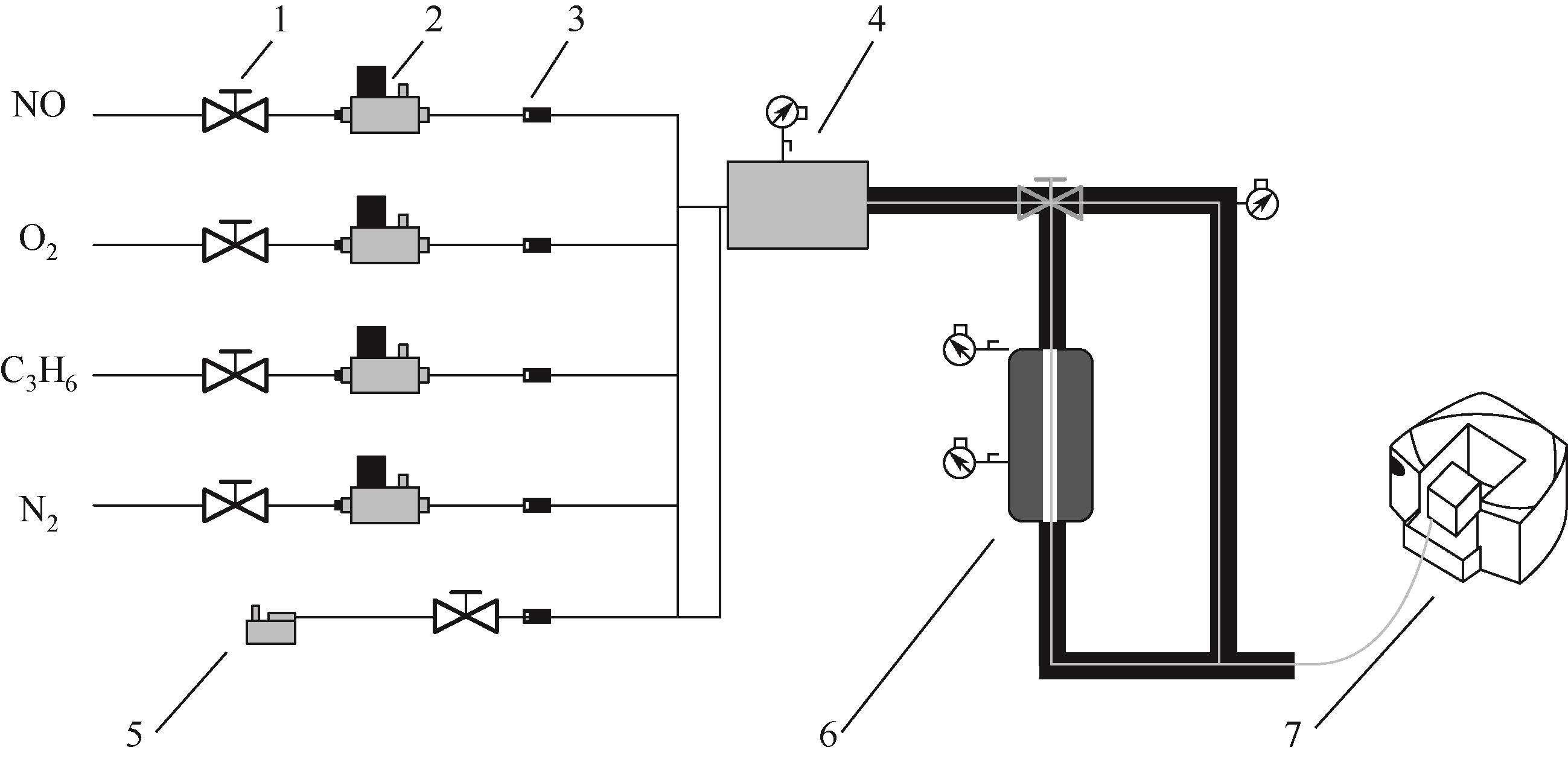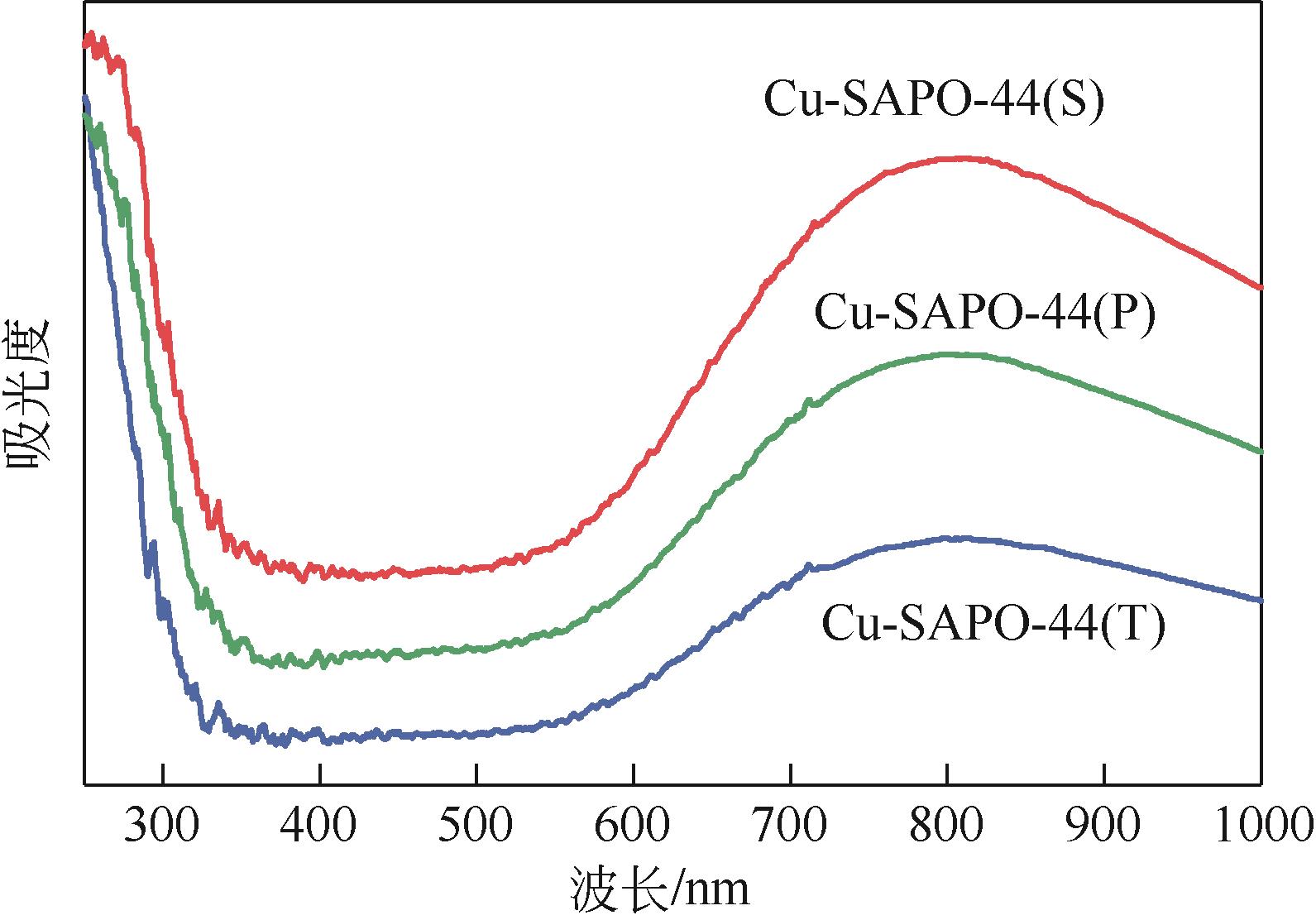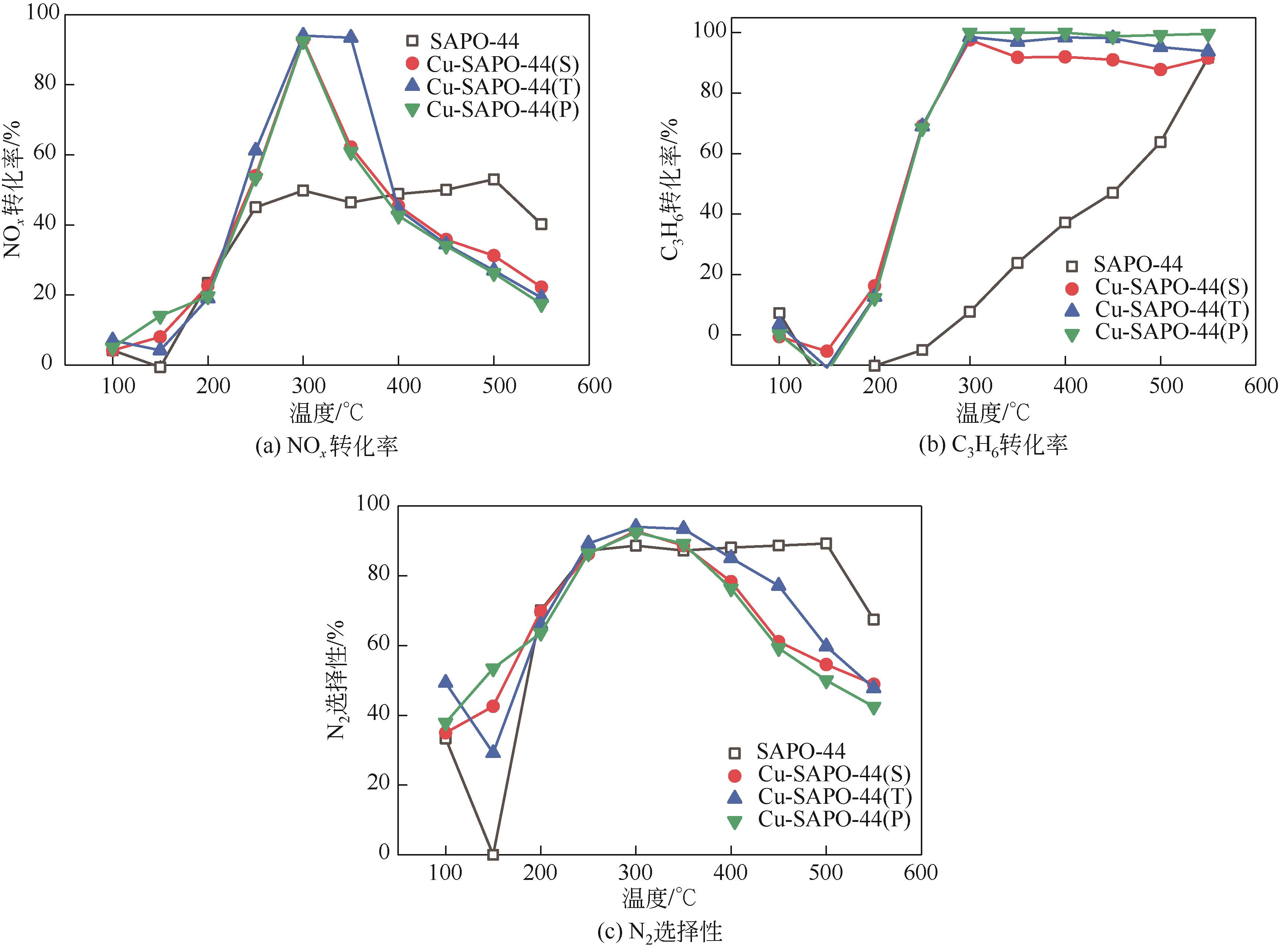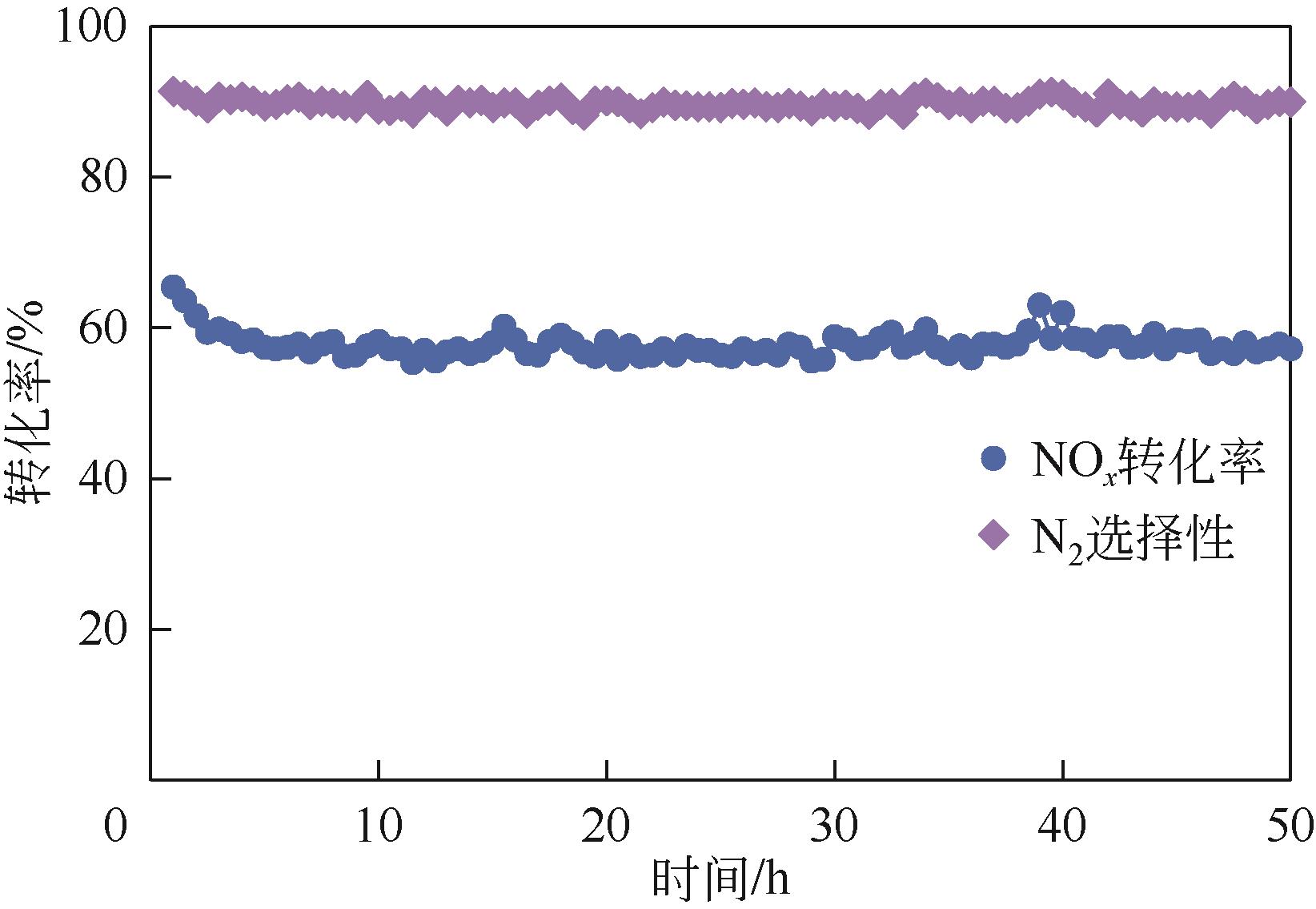化工进展 ›› 2023, Vol. 42 ›› Issue (3): 1373-1382.DOI: 10.16085/j.issn.1000-6613.2022-0815
Cu-SAPO-44分子筛的制备及其C3H6-SCR脱硝性能
周皞1( ), 张恒2, 温妮妮2, 王旭瑞1, 徐璐1, 李玮1, 苏亚欣2
), 张恒2, 温妮妮2, 王旭瑞1, 徐璐1, 李玮1, 苏亚欣2
- 1.常州工程职业技术学院,江苏 常州 213164
2.东华大学环境科学与工程学院,上海 201620
-
收稿日期:2022-05-05修回日期:2022-07-06出版日期:2023-03-15发布日期:2023-04-10 -
通讯作者:周皞 -
作者简介:周皞(1976—),男,博士,教授,研究方向为燃烧污染物生成与控制。E-mail:hzhou@czie.edu.cn。 -
基金资助:江苏省自然科学基金(BK20181161);国家自然科学基金(52276103);江苏省高等学校优秀科技创新团队项目(2019)
Preparation and de-NO x performance of C3H6-SCR over Cu-SAPO-44 catalyst
ZHOU Hao1( ), ZHANG Heng2, WEN Nini2, WANG Xurui1, XU Lu1, LI Wei1, SU Yaxin2
), ZHANG Heng2, WEN Nini2, WANG Xurui1, XU Lu1, LI Wei1, SU Yaxin2
- 1.Changzhou Institute of Engineering Technology, Changzhou 213164, Jiangsu, China
2.School of Environmental Science and Engineering, Donghua University, Shanghai 201620, China
-
Received:2022-05-05Revised:2022-07-06Online:2023-03-15Published:2023-04-10 -
Contact:ZHOU Hao
摘要:
分别采用以硫酸铜为铜源、环己胺为单模板剂,以硫酸铜为铜源、环己胺为模板剂、聚乙二醇(PEG2000)为协同模版剂,以Cu-TEPA(四乙烯五胺)和环己胺共模板剂3种制备方法,一步水热合成Cu-SAPO-44分子筛催化剂,用于选择性催化丙烯还原柴油机车尾气氮氧化物(C3H6-SCR)。采用X射线衍射、N2吸附-脱附、扫描电镜、紫外可见光谱、H2程序升温还原和NH3程序升温脱附等方法对催化剂进行表征,考察不同模板剂对Cu-SAPO-44物理化学特性和C3H6-SCR性能的影响。结果表明,以Cu-TEPA为模板剂制备Cu-SAPO-44时,Cu-TEPA既作为结构导向剂又提供活性铜物种,合成的分子筛结晶度高,铜负载量大,具有更多的活性Cu2+和丰富的表面酸性,为C3H6-SCR反应提供了大量的活性位点,因此具有最佳的脱硝性能。在含有10% O2和5% H2O的稀薄燃烧烟气条件下,在300~350℃可实现90%以上的NO x 转化率和N2选择性。而引入PEG2000对提高Cu-SAPO-44分子筛的脱硝效果不明显。经过50h的持续脱硝反应测试,Cu-SAPO-44(T)催化剂表现出良好的反应稳定性。
中图分类号:
引用本文
周皞, 张恒, 温妮妮, 王旭瑞, 徐璐, 李玮, 苏亚欣. Cu-SAPO-44分子筛的制备及其C3H6-SCR脱硝性能[J]. 化工进展, 2023, 42(3): 1373-1382.
ZHOU Hao, ZHANG Heng, WEN Nini, WANG Xurui, XU Lu, LI Wei, SU Yaxin. Preparation and de-NO x performance of C3H6-SCR over Cu-SAPO-44 catalyst[J]. Chemical Industry and Engineering Progress, 2023, 42(3): 1373-1382.
| 催化剂样品 | 元素质量分数/% | |||
|---|---|---|---|---|
| Cu | Al | P | Si | |
| Cu-SAPO-44(S) | 3.992 | 14.655 | 14.692 | 5.595 |
| Cu-SAPO-44(P) | 3.986 | 14.630 | 14.720 | 5.837 |
| Cu-SAPO-44(T) | 5.016 | 15.021 | 13.463 | 6.654 |
表1 不同模板剂合成的Cu-SAPO-44催化剂的各元素成分
| 催化剂样品 | 元素质量分数/% | |||
|---|---|---|---|---|
| Cu | Al | P | Si | |
| Cu-SAPO-44(S) | 3.992 | 14.655 | 14.692 | 5.595 |
| Cu-SAPO-44(P) | 3.986 | 14.630 | 14.720 | 5.837 |
| Cu-SAPO-44(T) | 5.016 | 15.021 | 13.463 | 6.654 |
| 催化剂样品 | 比表面积/m2·g-1 | 孔容量/cm3·g-1 | 孔径/nm |
|---|---|---|---|
| Cu-SAPO-44(S) | 602 | 0.226 | 1.788 |
| Cu-SAPO-44(T) | 488 | 0.182 | 1.498 |
| Cu-SAPO-44(P) | 577 | 0.216 | 1.498 |
表2 不同模板剂合成的Cu-SAPO-44催化剂的孔隙结构参数
| 催化剂样品 | 比表面积/m2·g-1 | 孔容量/cm3·g-1 | 孔径/nm |
|---|---|---|---|
| Cu-SAPO-44(S) | 602 | 0.226 | 1.788 |
| Cu-SAPO-44(T) | 488 | 0.182 | 1.498 |
| Cu-SAPO-44(P) | 577 | 0.216 | 1.498 |
| 催化剂样品 | 孤立Cu2+ | CuO | |||
|---|---|---|---|---|---|
| 峰面积 | 比例/% | 峰面积 | 比例/% | ||
| Cu-SAPO-44(S) | 94.60 | 28.8 | 234.43 | 71.2 | |
| Cu-SAPO-44(T) | 59.04 | 33.3 | 118.02 | 66.7 | |
| Cu-SAPO-44(P) | 77.48 | 30.7 | 174.80 | 69.3 | |
表3 不同模板剂合成的Cu-SAPO-44催化剂中铜物种的峰面积和百分比
| 催化剂样品 | 孤立Cu2+ | CuO | |||
|---|---|---|---|---|---|
| 峰面积 | 比例/% | 峰面积 | 比例/% | ||
| Cu-SAPO-44(S) | 94.60 | 28.8 | 234.43 | 71.2 | |
| Cu-SAPO-44(T) | 59.04 | 33.3 | 118.02 | 66.7 | |
| Cu-SAPO-44(P) | 77.48 | 30.7 | 174.80 | 69.3 | |
| 1 | 中华人民共和国环境保护部. 中国机动车污染防治年报[R]. 2021. |
| Ministry of Environmental Protection of the People’s Republic of China. China mobile source environmental management annual report[R]. 2021. | |
| 2 | ZHANG Ling, WU Qinming, MENG Xiangju, et al. Recent advances in the preparation of zeolites for the selective catalytic reduction of NO x in diesel engines[J]. Reaction Chemistry & Engineering, 2019, 4(6): 975-985. |
| 3 | 周远松, 高凤雨, 唐晓龙, 等. 金属氧化物催化CO还原NO的研究进展[J]. 化工进展, 2019, 38(11): 4941-4948. |
| ZHOU Yuansong, GAO Fengyu, TANG Xiaolong, et al. Research progress on NO reduction by CO over metal oxide catalysts[J]. Chemical Industry and Engineering Progress, 2019, 38(11): 4941-4948. | |
| 4 | WEN Nini, LIN Rui, SU Yaxin, et al. SCR of NO with CH4 over Fe/Ga2O3-Al2O3 and the mechanism[J]. Journal of Environmental Chemical Engineering, 2021, 9(1): 105014. |
| 5 | XU Junqiang, WANG Honglin, GUO Fang, et al. Recent advances in supported molecular sieve catalysts with wide temperature range for selective catalytic reduction of NO x with C3H6 [J]. RSC Advances, 2019, 9(2): 824-838. |
| 6 | 周皞, 葛梦瑶, 伍士国, 等. 载体对铁基整体式催化剂上丙烯催化还原NO的影响[J]. 化工进展, 2018, 37(12): 4693-4700. |
| ZHOU Hao, GE Mengyao, WU Shiguo, et al. Effects of supports on the iron based monolithic catalysts for NO reduction with propene[J]. Chemical Industry and Engineering Progress, 2018, 37(12): 4693-4700. | |
| 7 | ISHIHARA T, KAGAWA M, HADAMA F, et al. Copper ion-exchanged SAPO-34 as a thermostable catalyst for selective reduction of NO with C3H6 [J]. Journal of Catalysis, 1997, 169(1): 93-102. |
| 8 | YANG Jun, CHANG Yupeng, DAI Weili, et al. Ru-In/H-SSZ-13 for the selective reduction of nitric oxide by methane: Insights from temperature-programmed desorption studies[J]. Applied Catalysis B: Environmental, 2018, 236: 404-412. |
| 9 | YANG Jun, CHANG Yupeng, DAI Weili, et al. Bimetallic Cr-In/H-SSZ-13 for selective catalytic reduction of nitric oxide by methane[J]. Chinese Journal of Catalysis, 2018, 39(5): 1004-1011. |
| 10 | GAO Zhongnan, ZHAO Dongyue, YANG Yuexi, et al. Influence of copper locations on catalytic properties and activities of Cu/SAPO-34 in C3H6-SCR[J]. Industrial & Engineering Chemistry Research, 2021, 60(19): 6940-6949. |
| 11 | XIN Ying, WANG Xiao, LI Qian, et al. The potential of Cu-SAPO-44 in the selective catalytic reduction of NO x with NH3 [J]. ChemCatChem, 2016, 8(24): 3740-3745. |
| 12 | XIE Lijuan, LIU Fudong, SHI Xiaoyan, et al. Effects of post-treatment method and Na co-cation on the hydrothermal stability of Cu-SSZ-13 catalyst for the selective catalytic reduction of NO x with NH3 [J]. Applied Catalysis B: Environmental, 2015, 179: 206-212. |
| 13 | REN Limin, ZHU Longfeng, YANG Chengguang, et al. Designed copper-amine complex as an efficient template for one-pot synthesis of Cu-SSZ-13 zeolite with excellent activity for selective catalytic reduction of NO x by NH3 [J]. Chemical Communications, 2011, 47(35): 9789-9791. |
| 14 | MARTÍNEZ-FRANCO R, MOLINER M, FRANCH C, et al. Rational direct synthesis methodology of very active and hydrothermally stable Cu-SAPO-34 molecular sieves for the SCR of NO x [J]. Applied Catalysis B: Environmental, 2012, 127: 273-280. |
| 15 | XIN Ying, ZHANG Nana, WANG Xiao, et al. Efficient synthesis of the Cu-SAPO-44 zeolite with excellent activity for selective catalytic reduction of NO x by NH3 [J]. Catalysis Today, 2019, 332: 35-41. |
| 16 | YANG Di, ZHOU Hao, WANG Congying, et al. NO selective catalytic reduction with propylene over one-pot synthesized Fe-SAPO-34 catalyst under diesel exhaust conditions[J]. Fuel, 2021, 290: 119822. |
| 17 | WANG J H, ZHAO H W, HALLER G, et al. Recent advances in the selective catalytic reduction of NO x with NH3 on Cu-Chabazite catalysts[J]. Applied Catalysis B: Environmental, 2017, 202: 346-354. |
| 18 | 张恒, 周皞, 温妮妮, 等. Cu-SAPO-44选择性催化丙烯还原NO性能研究[J]. 燃料化学学报, 2022, 50(8): 1064-1074. |
| ZHANG Heng, ZHOU Hao, WEN Nini, et al. Selective catalytic reduction of nitric oxide with propylene over one-step synthesized Cu-SAPO-44 catalysts[J]. Journal of Fuel Chemistry and Technology, 2022, 50(8): 1064-1074. | |
| 19 | ZHOU Xiaoming, CHEN Zhuoyuan, GUO Zhiyong, et al. One-pot hydrothermal synthesis of dual metal incorporated CuCe-SAPO-34 zeolite for enhancing ammonia selective catalytic reduction[J]. Journal of Hazardous Materials, 2021, 405: 124177. |
| 20 | MUTTAKIN M, MITRA S, THU K, et al. Theoretical framework to evaluate minimum desorption temperature for IUPAC classified adsorption isotherms[J]. International Journal of Heat and Mass Transfer, 2018, 122: 795-805. |
| 21 | ZHANG Qiongdan, WANG Qiongsheng, WANG Shiming. Efficient heterogeneous Fenton-like catalysis of Fe-doped SAPO-44 zeolite synthesized from bauxite and rice husk[J]. Chemical Physics Letters, 2020, 753: 137598. |
| 22 | ZHOU Hao, YANG Di, WANG Congying, et al. Selective catalytic reduction of nitric oxide with propylene over one-step synthesized Cu-SAPO-34 catalysts[J]. Chinese Journal of Inorganic Chemistry, 2020, 36(10): 1997-2004. |
| 23 | 王聪颖, 周皞, 杨迪, 等. 一步水热合成Cu-SSZ-13分子筛选择性催化C3H6还原NO[J]. 无机化学学报, 2021, 37(5): 853-866. |
| WANG Congying, ZHOU Hao, YANG Di, et al. Selective catalytic reduction of NO with C3H6 over one-step hydrothermal synthesized Cu-SSZ-13 catalysts[J]. Chinese Journal of Inorganic Chemistry, 2021, 37(5): 853-866. | |
| 24 | NIU Can, SHI Xiaoyan, LIU Fudong, et al. High hydrothermal stability of Cu-SAPO-34 catalysts for the NH3-SCR of NO x [J]. Chemical Engineering Journal, 2016, 294: 254-263. |
| 25 | CAO Yi, FENG Xi, XU Haidi, et al. Novel promotional effect of yttrium on Cu-SAPO-34 monolith catalyst for selective catalytic reduction of NO x by NH3 (NH3-SCR)[J]. Catalysis Communications, 2016, 76: 33-36. |
| 26 | CAO Yi, ZOU Sha, LAN Li, et al. Promotional effect of Ce on Cu-SAPO-34 monolith catalyst for selective catalytic reduction of NO x with ammonia[J]. Journal of Molecular Catalysis A: Chemical, 2015, 398: 304-311. |
| 27 | XUE Junjie, WANG Xinquan, QI Gongshin, et al. Characterization of copper species over Cu/SAPO-34 in selective catalytic reduction of NO x with ammonia: Relationships between active Cu sites and de-NO x performance at low temperature[J]. Journal of Catalysis, 2013, 297: 56-64. |
| 28 | DONG Xuesong, WANG Jihui, ZHAO Huawang, et al. The promotion effect of CeO x on Cu-SAPO-34 catalyst for selective catalytic reduction of NO x with ammonia[J]. Catalysis Today, 2015, 258: 28-34. |
| 29 | NIU Can, SHI Xiaoyan, LIU Kuo, et al. A novel one-pot synthesized CuCe-SAPO-34 catalyst with high NH3-SCR activity and H2O resistance[J]. Catalysis Communications, 2016, 81: 20-23. |
| 30 | ZHOU Hao, GE Mengyao, ZHAO Huishuang, et al. Selective catalytic reduction of nitric oxide with propylene over Fe/beta catalysts under lean-burn conditions[J]. Catalysts, 2019, 9(2): 205. |
| 31 | WANG Lei, LI Wei, QI Gongshin, et al. Location and nature of Cu species in Cu/SAPO-34 for selective catalytic reduction of NO with NH3 [J]. Journal of Catalysis, 2012, 289: 21-29. |
| 32 | SUN Lijing, YANG Miao, CAO Yi, et al. A reconstruction strategy for the synthesis of Cu-SAPO-34 with excellent NH3-SCR catalytic performance and hydrothermal stability[J]. Chinese Journal of Catalysis, 2020, 41(9): 1410-1420. |
| 33 | 毛静雯, 徐斌, 胡宜康, 等. Ce金属改性对Cu-SAPO-34催化剂水热稳定性能的影响[J]. 燃料化学学报, 2020, 48(10): 1208-1215. |
| MAO Jingwen, XU Bin, HU Yikang, et al. Effect of Ce metal modification on the hydrothermal stability of Cu-SAPO-34 catalyst[J]. Journal of Fuel Chemistry and Technology, 2020, 48(10): 1208-1215. | |
| 34 | LI Junhua, ZHU Yongqing, KE Rui, et al. Improvement of catalytic activity and sulfur-resistance of Ag/TiO2-Al2O3 for NO reduction with propene under lean burn conditions[J]. Applied Catalysis B: Environmental, 2008, 80(3/4): 202-213. |
| [1] | 杨建平. 降低HPPO装置反应系统原料消耗的PSE[J]. 化工进展, 2023, 42(S1): 21-32. |
| [2] | 王福安. 300kt/a环氧丙烷工艺反应器降耗减排分析[J]. 化工进展, 2023, 42(S1): 213-218. |
| [3] | 王乐乐, 杨万荣, 姚燕, 刘涛, 何川, 刘逍, 苏胜, 孔凡海, 朱仓海, 向军. SCR脱硝催化剂掺废特性及性能影响[J]. 化工进展, 2023, 42(S1): 489-497. |
| [4] | 邓丽萍, 时好雨, 刘霄龙, 陈瑶姬, 严晶颖. 非贵金属改性钒钛基催化剂NH3-SCR脱硝协同控制VOCs[J]. 化工进展, 2023, 42(S1): 542-548. |
| [5] | 孙玉玉, 蔡鑫磊, 汤吉海, 黄晶晶, 黄益平, 刘杰. 反应精馏合成甲基丙烯酸甲酯工艺优化及节能[J]. 化工进展, 2023, 42(S1): 56-63. |
| [6] | 王晋刚, 张剑波, 唐雪娇, 刘金鹏, 鞠美庭. 机动车尾气脱硝催化剂Cu-SSZ-13的改性研究进展[J]. 化工进展, 2023, 42(9): 4636-4648. |
| [7] | 李佳, 樊星, 陈莉, 李坚. 硝酸生产尾气中NO x 和N2O联合脱除技术研究进展[J]. 化工进展, 2023, 42(7): 3770-3779. |
| [8] | 张巍, 秦川, 谢康, 周运河, 董梦瑶, 李婕, 汤云灏, 马英, 宋健. H2-SCR改性铂系催化剂低温脱硝的应用及性能强化挑战[J]. 化工进展, 2023, 42(6): 2954-2962. |
| [9] | 王子宗, 刘罡, 王振维. 乙烯丙烯生产过程强化技术进展及思考[J]. 化工进展, 2023, 42(4): 1669-1676. |
| [10] | 李云闯, 谢方明, 席亚男, 万新月, 孙玉虎, 赵永峰, 李根, 刘宏海, 高雄厚, 刘洪涛. 高水热稳定性介孔分子筛的低成本合成研究进展[J]. 化工进展, 2023, 42(4): 1877-1884. |
| [11] | 常晓青, 彭东来, 李东洋, 张延武, 王景, 张亚涛. MOFs基丙烯/丙烷高效分离混合基质膜研究进展[J]. 化工进展, 2023, 42(4): 1961-1973. |
| [12] | 张孟旭, 王红琴, 李金, 安霓虹, 戴云生, 钱颖, 沈亚峰. PtSn/MgAl2O4-sheet催化剂的制备及其PDH反应性能[J]. 化工进展, 2023, 42(3): 1365-1372. |
| [13] | 胡兆岩, 张景新, 何义亮. Fe负载污泥生物炭催化热解聚丙烯及产物特性[J]. 化工进展, 2023, 42(2): 631-640. |
| [14] | 辛华, 彭琪, 李阳帆, 张岩, 陈悦, 李新琦. 含氟聚氨酯二甲基丙烯酸酯为芯材的微胶囊制备及自修复性能[J]. 化工进展, 2023, 42(10): 5406-5413. |
| [15] | 刘亮, 王朝曦, 李鑫龙, 张高山, 王守阳, 张林林, 陆畅, 卿梦霞. 钒钛系脱硝催化剂抗硫酸氢铵中毒改进措施研究进展[J]. 化工进展, 2023, 42(1): 215-225. |
| 阅读次数 | ||||||
|
全文 |
|
|||||
|
摘要 |
|
|||||









